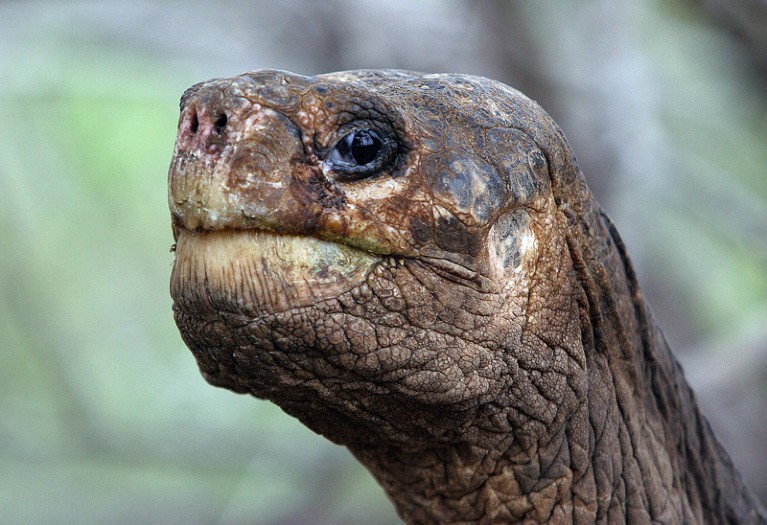
The giant tortoise Lonesome George, who died in 2012, was the last member of the species Chelonoidis abingdonii.Credit: Rodrigo Buendia/AFP/Getty
Lonesome George, the last member of Chelonoidis abingdonii, a species of giant tortoise endemic to the tiny island of Pinta in the Galapagos Islands, did not die in vain. Researchers this week present his genome in the journal Nature Ecology and Evolution (V. Quesada et al. Nature Ecol. Evol. https://doi.org/10.1038/s41559-018-0733-x; 2018), along with the genome of George’s distant but still-extant cousin, the Aldabra giant tortoise Aldabrachelys gigantea. Comparison of these genomes with those of a diverse range of species unlocks a treasure trove of secrets about how giant tortoises get to be so large, long-lived (typically up to a century) and resistant to infections and cancer.
Once upon a time, islands from Malta to Mauritius could boast their own species of giant tortoise. But nowhere is more synonymous with giant tortoises than are the Galapagos Islands — literally so, because the archipelago gets its name from galápago, a Spanish word for turtle. Marooned in isolated spots and free from predators, Galapagos tortoises became larger than their mainland ancestors, and, having rather relaxed metabolisms, they are able to survive on the meagre rations available on islands. Slow metabolism and large size tends to correlate with long life and infrequent reproduction. It’s no surprise, therefore, that the arrival of humans marked out giant tortoises as ripe for extinction. These large creatures moved too slowly to escape slaughter, and bred too infrequently to compensate for the loss. Even when they did manage to breed, their eggs and young were easy prey for other introduced species such as rats, the eradication of which is seen as key to the recovery of giant tortoise populations (see W. T. Aguilera et al. Nature 517, 271; 2015).
Humanity, however, wasn’t solely to blame. Comparison of the genome of Lonesome George — who died in 2012 — with that of other tortoises shows that the effective population size of his species had been in slow decline for at least one million years. This is only to be expected for a species of large, slowly reproducing animal confined to a small island, where the choice of mate is limited. The Aldabra giant tortoise experienced more ups and downs; but for isolated island species, downs can all too often prove catastrophic.
Animals that live for a long time take pains to avoid early death, and giant tortoises are among the longest-lived of all land animals. Although the genetics of longevity has been explored in long-lived mammals, extending it to tortoises should illuminate more-general hallmarks of the genetic basis of longevity.
Genes under positive selection in giant tortoises include those whose expression has also been connected with a ripe old age in humans. A detailed study of 891 genes involved in the function of the immune system revealed duplications in tortoise genes not seen in humans, and there are more tumour-suppressor genes in giant tortoises than in vertebrates in general. Duplications of at least one proto-oncogene involved in mitochondrial health might relate to an improved response to oxidative stress, known to be an important factor in ageing. Likewise, duplications of genes involved in DNA repair have been noted as related to longevity in several species. A variant of a gene involved in DNA repair is also present in the long-lived naked mole-rat (Heterocephalus glaber), presumably an example of convergent evolution. Likewise, expansion of an elongation factor has been linked with the longevity of Drosophila fruit flies in which this gene is overexpressed. And so on.
And yet a turtle is a still a turtle. Some details of the giant-tortoise genomes could shed light on aspects of the peculiar evolution and development of tortoises, such as their shell. One should therefore be cautious in applying the lessons of tortoise longevity directly to humans. The longevity of a species is more than a matter of a list of genes — it’s connected with all aspects of the species’ life history. Although the naked mole-rat can live for 30 years, this marks it out as peculiarly long-lived only for rodents, whose lives are generally fast, frenetic and short. It’s no great shakes compared with a tortoise, a human or indeed a bowhead whale, whose two-century lifespan makes it the longest lived of all mammals — and which doubtless has many other whale-specific peculiarities. Faced with the specific fate of one’s species, life remains very much what you make it.

 The legacy of Lonesome George
The legacy of Lonesome George
 Lonesome George 'look-alike' captured for tortoise-breeding effort
Lonesome George 'look-alike' captured for tortoise-breeding effort








